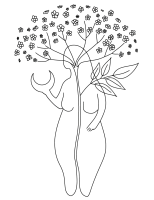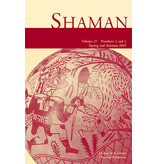Shaman (ISARS) - Volume 27
SHAMAN
De jaarlijkse uitgave van de ISARS (International Society for Academic Research in Shamanism).
Dit is Volume 27 (metr daar Spring/Autumn 2019)
Inhoud artikelen:
MARYAM ABBASI (HEIDELBERG, GERMANY):
Crisis, Agency and Negotiating Gender Identity: An Ethnographic Study of Female Participants in the Zār Ritual in the Hormozgān Province of Iran
In southern Iran, the zār ritual is a community-based activity which is used to treat people who are believed to be possessed by spirits. The most important spirit, called zār, gives the possessed person a divine power in the eyes of others, in which she/he is allowed to ignore some social norms and enjoy societal respect without any punishment. From 2010 to 2016 I interviewed over fifty participants and non-participants in the zār ritual and reviewed the literature in order to evaluate different aspects of the ritual. My fieldwork indicates that the zār participants tend to be the most vulnerable and powerless members of society, who through their participation are able to avoid some of their gender-based predicaments and particular crises. The main research questions I sought to answer are: What are the predicaments and crises which lead women to turn to the zār ritual for help? And how does participation in the zār ritual facilitate their recovery? How do the women see this process?
JAKOB ASKJER (TØNSBERG, NORWAY):
The Evidence of Shamanism and Psychoactive Plant Use in Pre-Columbian Art from the Andes
This article examines the prevalence of shamanism and the use of psychoactive plants among the pre-Columbian cultures and civilizations in the Andes as evidenced by their respective iconography and depictions in various forms of art. The iconography of this prehistoric art in relation to modern-day beliefs and practices strongly suggests the cultural and spiritual importance of shamanism and entheogens among the pre-Columbian Andeans.
N. HARRY ROTHSCHILD (UNIVERSITY OF NORTH FLORIDA):
Beyond Venom and Malediction: Shamanism under Female Emperor Wu Zhao
Drawing upon both official state histories and a wide range of unofficial sources, this article examines both state-sponsored shamanism in the Tang dynasty (618–907) and the evolving and often constructive roles that shamans played during the ascendancy and reign Wu Zhao 武曌 (624–705, r. 690–705), China’s first and only female emperor.
DIRK SCHLOTTMANN (BERLIN):
Dealing with Uncertainty: Hell Joseon and the Korean Shaman Rituals for Happiness and against Misfortune
Shamanism is still a popular form of spiritual-religious practice despite recent socioeconomic development in South Korea. The following essay examines the changes in jaesugut (ritual for happiness) and uhwangut (ritual against misfortune), both adapted to the demands of modern urban life. These adjustments are a response to social transformations and the resulting altered ideas of happiness and success. The emphasis on this worldly wish-fulfillment of Korean shamanism is a mirror of the zeitgeist and allows insights into people’s wishes, needs and worries. In addition, this investigation examines how shamans, clients and spirits address and discuss the causes of good and bad fortune during the rituals. The ritual is an endeavor to make sense of the human experience and creates a spiritual reconstruction of reality that aims to transform the participant’s negative emotions into meaningful experiences and to overcome crisis. Ritual efficacy is based on the competence of the shaman to act as a mediator between the human and supernatural worlds and to connect these spheres meaningfully and creatively with each other. The analysis of the rituals is the result of several years of field research in close collaboration with Korean shamans of the Hwanghaedo tradition in the area of Seoul.
GÁBOR VARGYAS (BUDAPEST):
Yao Prông: Feast for the Helping Spirit of the Bru Shaman
Yao prông, the feast for the helping spirit, is the greatest yearly shamanic event among the Bru, a central Vietnamese hill tribe. Every Bru shaman’s house has a beautifully decorated altar, where the shaman’s helping spirit is thought to reside. Before performing, the shaman calls upon his helping spirit to follow him to the scene and help him in his “work,” after which the spirit returns to the altar. Once a year the whole village, i.e. the real and virtual clientele of the shaman, come together at this altar to honor the helping spirit, and, through it, the shaman. At this occasion the altar is repainted and remade, and during twenty-four hours of grandiose ceremony the shaman cures again all his former patients for a “last” time, thus bringing their illness symbolically to an end. In my paper I present a processual analysis of the feast with special attention given to the making of the altar and its symbolism, to creating ritual space and to spiritual performativity in front of the altar.
GILL WOODS (READING, UK):
Evidence of Shamanism in Early Predynastic Egypt
Three C-ware or White cross-lined vases (Cairo Museum JdE 99072; Musées Royaux d’Art et d’Histoire, Brussels: E. 3002 and the Petrie Museums: UC15339) dating to Naqada I (ca. 4000–3500 b.c. ) have thematically similar motifs comprising at least one large human figure with arms held aloft and curved over the head in the style of bovine horns who is accompanied by a much smaller human figure or figures. The motifs have been interpreted by Egyptologists as depicting dance or war/victory scenes. However, with reference to anthropological thinking, the motifs can be interpreted as depicting an initiation ritual led by a shaman.
Short Communications
YULIYA ABSALYAMOVA (ÖFÖ, BASHKORTOSTAN, RUSSIAN FEDERATION):
The Cult of Sacred Springs among the Bashkir
GYÖRGY KARA (INDIANA UNIVERSITY, BLOOMINGON, IN, USA):
Rinchen’s Shorthand Mongol Note Written for Vilmos Diószegi
Book Reviews
Davide Torri
GREGORY SHUSHAN: Near-Death Experience in Indigenous Religions. New York and Oxford: Oxford University
Museum and Exhibition Reviews
Dávid Somfai Kara
Shamanic Artifacts in the Collection of the National Museum of Ethnology, Japan




